 |
 |
 |
Our route:
21.08.02 - 23.08.02:
Suwalki
Lake Wigry
24.08.02:
Mazuren
Gizycko
25.08.02:
Ketrzyn (Goerlitz)
Wolfsschanze
Swieta Lipka
26.08.02:
Reszes
LidzbarkWarminski
Frombork
27.08.02 - 29.08.02:
Hel
30.08.02 - 01.09.02:
Gdansk (Danzig)
02.09.02:
Malbork
03.09.02:
Pelplyn
04.09.02:
Chelmno
05.09.02:
Ciechocinek
06.09.02:
Torun
07.09.02:
Plock
08.09.02 - 11.09.02:
Warszawa
12.09.02:
Lowicz
13.09.02:
Czestochowa
14.09.02:
Oswiecim/Auschwitz
15.09.02:
Ojcow
16.09.02 - 20.09.02:
Krakow
21.09.02 - 22.09.02:
Pieniny mountains
23.09.02 - 27.09.02:
Zakopane
High Tatra
|
|
 |
| Poland |
 |
 |
 |
 |
 |
 |
On this page, we (will) describe our experiences in Poland.
Apart from the travelogue for this country
you will also find a number of links to useful sites,
ranging from general information to embassy homepages.
Written by: Coen
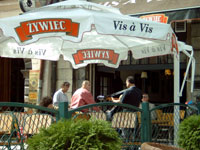 The 22nd of August we crossed the border to Poland without any complications. No burocratic officers and no muddy boots in our car. We drove directly to the"Suwalki" national park. It was nice not being stared at all the time and it was nice that people speak a second language although the North is the poorest part of Poland.
The 22nd of August we crossed the border to Poland without any complications. No burocratic officers and no muddy boots in our car. We drove directly to the"Suwalki" national park. It was nice not being stared at all the time and it was nice that people speak a second language although the North is the poorest part of Poland.
We felt happy to enter the country of the storks, the car mechanics and the Fiat Polski's.
We found a nice little camping site where we spent a few days; we rent a kayak and floated over the Wigry lake, a easy and non-touristy lake district, we felt the stillness of the Wigry-convent and we sat along a campfire with Polish and German people.
After a few days we wanted to hit the road again and we filled our water tank with water from a well and said goodbye to our campfire friends. We drove in direction Masuren national park.
The landscape of the North of Poland is something special; we drove over hilly roads with sloping fields left and right. Old wooden farms and beautiful lanes with old oaks along the roadside. We passed cornfields, little farmer villages and small Polish cars packed with all sorts of stuff drove past.
And the sun is still with us.
On our way to the Masuren we wanted to visit the "Wolfschanze".
This was the Nazi headquarter during WOII and it was here general Von Stauffenberg made an attempt to kill Adolf Hitler.
It is a huge area with bunkers and buildings in the middle of a forest. Over 2000 people live and worked here and Hitler himself lived here more than 800 days in a bunker with 5 meter thick walls. When the Russians came, the Germans blew up the whole area so it is more like a ghost town. We were not allowed to leave the trail because of mines.
At the end of the day we arrived at Lipka to visit the famous pilgrim cathedral Swietka Lipka. We were surprised by some Polish hospitality; father and son directed us to their garden where we could spend the night for only 1 zloty (0,25 Euro) and where we could use a corner as a toilet. I had mercy ;-)
Early in the morning we visited the cathedral and enjoyed an organ recital by the beautiful organ from 1721 with its 4000 organ pipes and its moving figures.
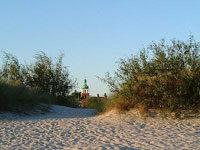 Next we drove to Reszes, a medieval town that didn't lose its originality through the years. A wonderful castle, an early-medieval church and authentic medieval houses with accompanying despicable stray dogs. There used to be many of these medieval villages in Poland but most of them were destroyed during WOII.
Next we drove to Reszes, a medieval town that didn't lose its originality through the years. A wonderful castle, an early-medieval church and authentic medieval houses with accompanying despicable stray dogs. There used to be many of these medieval villages in Poland but most of them were destroyed during WOII.
From Reszes we drove to Fromborg, the birth city of Copernicus. It was a road in terrible condition and we thanked our holy reinforced suspension.
In the evening we went to Fromborg's harbor to find a visa-free boat tour to Kaliningrad but unfortunately the Russians do not want to let us in without visa.
The next morning we visited the enormous castle of the Teutonic knights in Fromborg and drove due north afterwards, since we were eager to get to the peninsular Hel at the Baltic sea.
The peninsular Hel was only opened to the public a few years ago, because this 1 km broad and 40 km long island was used for military purposes. The core consists of pine forest and is surrounded by beautiful white beaches. When we stuffed our car in a little private garden, the owner did not like the fact that no other car could fit in. In Hel were lots of fish restaurants and cosy pubs and there were seal warning tables on the beach.
The 28th of August we celebrated our 10th anniversary with a 15 kilometers walk over the beautiful unspoiled white beaches. Then we picked a hotel a spend the afternoon in the swimming pool and whirlpool. For dinner we went to a splendid fish restaurant and ate "kaubastian" herring and drank "Ciel de Paris". The waitress from the breakfast terrace recognized us and finally we were drinking vodka with Polish fishermen. Later we went to a nightclub with them and we ended drunk on the beach.
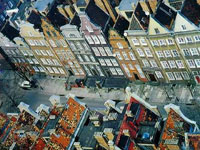 From Hel we drove to Gdansk, of which we expected a lot. The road through the center was an experience because everybody drives however he/she likes it. Old Lada's and FSO's with few horsepower try to overtake the slower trucks and a 2-lane road turns into a four-lane quickly. Dorrit guided us to a parking place in the middle of the center. For dinner we had "Pierogi", a polish specialty which is a sort of big ravioli with different exciting fillings.
From Hel we drove to Gdansk, of which we expected a lot. The road through the center was an experience because everybody drives however he/she likes it. Old Lada's and FSO's with few horsepower try to overtake the slower trucks and a 2-lane road turns into a four-lane quickly. Dorrit guided us to a parking place in the middle of the center. For dinner we had "Pierogi", a polish specialty which is a sort of big ravioli with different exciting fillings.
The next morning we saw that our parking place was next to the shipyard of Gdansk where Lech Walesa organized the Solidarinosc revolts. Because of these revolts, the first non-communist party was allowed which finally meant the fall of the communism in Poland (and the rest of Eastern Europe) in 1989.
In the center of Gdansk we walked through the golden gate to the King's street. Gdansk is a beautiful town which was rebuild in the old style in the 50's after the complete destruction in WOII.
We visited the town hall, a museum about the turbulent years in Gdansk and we loafed along the old harbor. Lots of old churches and small narrow streets brings you 100 years back in time. At night we enjoyed "Gdansk by night".
The next day we went to see an old guild house and finally the old center of Gdansk; the old medieval mill, the mansions and the Arthushouse.
Today it is the first of September, exactly 63 years ago the Germans attacked the polish Westerplatte which started the WOII, that's why the next day at 10 am we took a boat to the Westerplatte.
We sailed through the deepest of the Gdansk harbor and along the Solidarinosc shipping yards. After 1,5 hours we arrived at the coast. It was very impressive to walk along the ruins of the battle fields and at the monument there was an old man sharing his memories about the war. We took the last boat back to Gdansk and we said goodbye to the sea. Next meeting will be in Greece. We sailed along massive scrap heaps and we saw huge Iranian oil tankers.
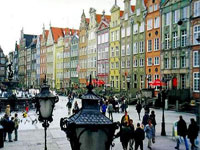 This same evening we drove to Marienburg, the capital of the Teutonic knights (Deutsche Orde). Here their main fortress was build. On the camping site we met a Dutch couple Wytske and Martijn who are going to drive to Africa next year in a Volkswagen LT, the same type of car that we have. We hope to meet each other in Turkey next near.
This same evening we drove to Marienburg, the capital of the Teutonic knights (Deutsche Orde). Here their main fortress was build. On the camping site we met a Dutch couple Wytske and Martijn who are going to drive to Africa next year in a Volkswagen LT, the same type of car that we have. We hope to meet each other in Turkey next near.
After breakfast we visited the Marienburg. It was only possible to enter the fortress by group but once we were inside, we bought a guide and left the group. It took us 3 ˝ hours to get back to the entrance. It is an enormous building with towers, huge halls and drawbridges. We walked via small stairs through different parts of the fortress, sometimes through the old castle moats. Here we could have spend the whole day.
Via Pelplin we drove to the medieval Chelmno. We looked at the town, walked along the old city walls and a friendly Polish guy brought us to the best internet café in town.
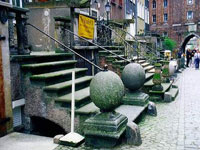 On the way to Torun we wanted to drive to Ciechocinek because this should be a health resort with a spa. We drove the red road in direction Torun with mushroom-sellers, prostitutes and fancy motel-restaurants along the roadside.
In Ciechocinek, in a sanatorium hotel, we enjoyed dead-see-salt-whirlpools and sat together in a mini Turkish steam bath. Actually we only wanted to swim. After a cold shower and a soda we drove on to Torun.
On the way to Torun we wanted to drive to Ciechocinek because this should be a health resort with a spa. We drove the red road in direction Torun with mushroom-sellers, prostitutes and fancy motel-restaurants along the roadside.
In Ciechocinek, in a sanatorium hotel, we enjoyed dead-see-salt-whirlpools and sat together in a mini Turkish steam bath. Actually we only wanted to swim. After a cold shower and a soda we drove on to Torun.
On a guarded parking place the rain ticked on the roof for the first time in weeks. I hope it will not rain tomorrow, because that is Dorrit's birthday. On this day we went to visit Torun, had coffee with cake because the Polish are good at making cakes. We had dinner in an authentic Polish restaurant with long wooden tables and waiters in traditional dress. Later that night a birthday cocktail in a dancing.
Next afternoon in Plock at a south-German looking (Odenwald) square, we shared memories about the good old times.
Once a day a bronze cuckoo-knight appears from the tower of the city hall and a (real) soldier plays on a trumpet on top of the tower.
Beneath the castle of Plock, at the river Wisla, is an amphitheater and here we went to a free concert of a famous Polish singer. It was very nice to be able to enjoy this piece of Polish temperament. The public clapped, leaped about and sang. Some of them could not resist the Greek-style melodies any longer and jumped of their seats to dance. We enjoyed the atmosphere on this warm late summer night and we had a beautiful view from above the stage over the river with its boat lights.
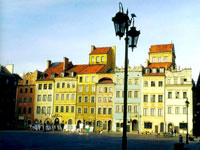 We arrived in Warsaw at 3 pm the next afternoon and we were lucky again because there was a music festival going on in the city center. So we sat in the sun again with our hidden beer cans (public drinking is forbidden in Poland) and listened to the live music. At night we walked through the city center and concluded that we were in a wonderful city again.
All in all we spent three days in Warsaw and we "lived" on a transfer area for new Renaults (therefore guarded).
We arrived in Warsaw at 3 pm the next afternoon and we were lucky again because there was a music festival going on in the city center. So we sat in the sun again with our hidden beer cans (public drinking is forbidden in Poland) and listened to the live music. At night we walked through the city center and concluded that we were in a wonderful city again.
All in all we spent three days in Warsaw and we "lived" on a transfer area for new Renaults (therefore guarded).
Most of Warsaw was destroyed in WWII and rebuilt in old style (according to 17th century paintings). We walked to one of the few remaining streets of the old Jewish ghetto. The ghetto including its 300.000 inhabitants (30% of the Warsaw citizens) was completely destroyed after the Jewish revolt.
On our way to the Saxon garden we passed the culture palace, a huge building that looks like the empire state building. It was build by the Russians as a present for the Poles. For the Polish people it is mainly a remembrance of the bad old times. Funny detail were the huge Newsweek billboards on the outside.
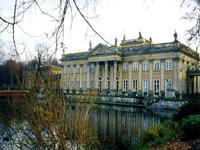 The next day we walked a part of the "street of remembrance, the suffering and the battle of the Jews" and we passed the "Umschlagplatz" where the Jews were gathered to be put on the trains to the KZ Treblinka.
The next day we walked a part of the "street of remembrance, the suffering and the battle of the Jews" and we passed the "Umschlagplatz" where the Jews were gathered to be put on the trains to the KZ Treblinka.
Next we went to the monument of the Warsaw revolt, a remembrance to the 50.000 Polish soldiers and citizens who, supported by the government in exile, started a revolt (partly in the drainages) against the German occupiers.
We ended this day with a long walk on the "kings road", the most beautiful part of Warsaw. We walked along the Radziwill-palace where the Warsaw treaty was being signed, along Jugendstil buildings, along the university and we passed a boulevard with the name "new world" with it's lovely terraces. Everywhere on the outside walls you see the marks of the artillery fire from the WWII.
Eventually we arrived at the Lazienki palace with it's splendid different gardens.
On our last day in Warsaw we woke up early to get to the Jewish museum on time. This museum was mainly about the Warsaw ghetto, the life in there and the revolt of the Jews. It is a black spot in history of Poland.
At 12:00 am we went to the historical museum to see a movie with a lot of old film material from the old Warsaw and later on in the museum, we were astonished by the detailed 17th century paintings which were used to rebuild Warsaw after the war.
The same day we drove to Nieborow, an 18th century forest castle where we walked in the autumn gardens. We spent the night in Lowicz.
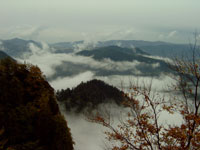 When I woke up from a deep sleep "in the wild", I realized the autumn was coming. It was cold, the leaves are getting yellow and the change of the season is in the air.
When I woke up from a deep sleep "in the wild", I realized the autumn was coming. It was cold, the leaves are getting yellow and the change of the season is in the air.
In the place of pilgrimage Czestochowa we went to see the painting "black Madonna". In the holy place Jasna Gora it was full of nuns, priests and other worshippers. The walls of the holy room were full of crutches and protheses from people who were healed after seeing the black Madonna.
At the end of the day we drove to Auschwitz. We spent the night on the parking place next to the concentration camp.
It wasn't a good sleep.
After breakfast we visited the camp Auschwitz I and the destruction camp Auschwitz-Birkenau. What terrible suffering.
At night we drove as far as possible to get away from that place.
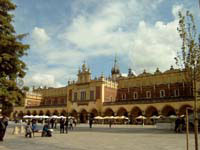 To clear our minds we drove to the Narodowy national park. We walked along Jura stone formations, walked through beautiful green valleys and climbed over hilltops. It was raining and autumn was in the air.
To clear our minds we drove to the Narodowy national park. We walked along Jura stone formations, walked through beautiful green valleys and climbed over hilltops. It was raining and autumn was in the air.
Next morning we drove to Krakow to meet my mother and Martin. We have spent 5 nice days on a camping site, we had a lot to talk about and we visited Krakow.
Krakow has survived the WWII without much damage. It is beautiful city with a rich fortress and old streets. We also went to the salt mines of Wieliczka and joined a 2,5 kilometers guided tour through the deepest tunnels of the mine. Marvellous salt sculptures, subterranean churches with altars and holy figures made out of salt. We went up again in a claustrophobic little mineworker elevator.
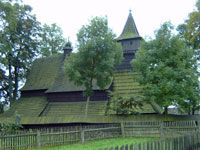
After saying goodbye to my mother and Martin, we drove in direction Zakopane in the high Tatra for a few days of trekking.
The first day we climbed the 3 crones mountain in the Pieniny national park. We had a great view over the Dunajec valley. The forest is in beautiful autumn colors and the valley laid in a cloudy bath.
Than we drove to Zakopane by car and we were nearly drowned by the heavy rain when we walked to the Morskie Oko mountain lake. The next day we walked to a monastery and we had a decent climb on our sneakers.
We ended our last day in Poland with a very beautiful walk in the Tatra with murmuring mountain streams, steep rock masses and huge stones covered with moss, all through a filter of clouds.
To conclude our visit to Poland we had Zurek (Polish sour soup) and Pierogi with garlic for dinner.
We will definitely come back to Poland.
Coen
|
 |
|
 |
 |
 |
 |
Our top 6: |
 |
 |
1. Gdansk and Hell
2. Warszawa
3. Pieniny mountains
4. Malbork
5. Wigry
6. Ojcow
|
 |
 |
 |
 |
 |
 |
|


